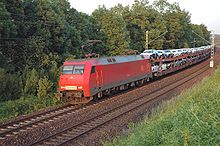Train (rail transport)
A train (also known as “a train journey”) is a group of rail vehicles that is transferred to the free route . In Switzerland, train journeys are also referred to as signal journeys. They differ from shunting trips in a train station or parked trains.
A combination of rail vehicles - regardless of whether it is running or parked as a train journey or shunting movement - is referred to as a train formation or train unit . In Switzerland, where the first term for units running one after the other on a timetable route in follow-up train operations, the terms train composition or train composition are used. The coupled wagons without a locomotive are called wagon train in Germany and Austria .
definition
Germany
For railways in Germany, trains are defined in Section 34 (1) of the Railway Construction and Operating Regulations (EBO):
“Trains are the units consisting of standard vehicles, moved by machine power and individually moving locomotives that move onto the open line . Suitable auxiliary vehicles may be treated like trains or placed in trains. "
The EBO contains further provisions for trains in Sections 34 and 35, such as B.
- Train tail and headlights (Section 34, Paragraph 6),
- Length limitation (Section 34 (8)),
- Braking (§ 35).
Each train journey is assigned a train number that is unique for each day and infrastructure operator .
The requirement to move to the open road is out of date, as with the introduction of electronic interlockings ( ESTW ), more and more formerly separate operating points are combined into one operating point from a safety point of view, especially where there are no other points due to the "overlapping" of the entry signals free route would be available. Therefore, the DB Netz rules and regulations require a timetable to be available:
"Trains are individually moving traction vehicles or units that move onto the open track or run within a station according to a timetable, which can be composed of working traction vehicles or working traction vehicles and the wagon train in which the wagons or non-working traction vehicles are set.
Suitable auxiliary vehicles may be treated like trains or placed in trains. The railway company informs the train crew which auxiliary vehicles are suitable for trains.
Trains are divided into passenger and freight trains. "
The definition for trams in Germany given in § 1 BOStrab gives something similar:
“Trains are units that move onto mainline tracks. They can run as passenger or company trains and consist of one or more vehicles. "
Other countries
In Switzerland, “single or coupled locomotives with or without wagons that go onto the route from the time they are taken over by the drivers […] until their arrival […], except during shunting movements” are regarded as a train. A train journey describes a “journey in the station and on the route that is secured and regulated by main signals , as well as trains in the area with driver's cab signaling ”.
According to the Austrian definition:
"Trains are tractors that go on the open track alone or with other vehicles."
There are similar definitions in other countries.
A train composition can complete several train journeys one after the other (with different train numbers). It is also possible that change during a train ride on the road, the vehicles (completely or partially) - for example, in coaches or Zugtausch - but the same schedule continues.
Trains from other transport systems than rail are often colloquially referred to by the name of the transport system, e.g. B. Tram trains as trams.
Types of train formation

With regard to the type of vehicles and their arrangement in the train, the following types of train formation are distinguished:
- So-called "locomotive- hauled " trains carried by a locomotive . The locomotive can be at the top (often referred to as the “Zugspitze”) of the rolling stock or at another point in the train, seen in the direction of travel . In any case, however, the train must be controlled from the top, if necessary from a control car . If this is the case in both directions, it is also referred to as a push-pull train , as it is possible to change the direction of travel without changing the composition of the train.
- Multiple units , self-propelled units made up of several vehicles that cannot be separated during regular operation. They are depending on the function than railcars / Triebkopf called, middle and end cars. For example, the ICE 1 of the DB AG are multiple units that are driven and controlled by one power car at each end of the train.
- Multiple units. They consist of one or more outside separable workshops and detachable instinctual , Central , examples and control car .
Types of transportation
Trains are also differentiated according to the type of what they transport:
- Passenger trains carry travelers .
- Freight trains transport cargo .
- Mixed trains transport both travelers and goods.
- Locomotive trains are trains that consist exclusively of one or more locomotives.
Zugspitze and Zugschluss
The front end of a train in the direction of travel is generally referred to as the Zugspitze , the rear end in the direction of travel as the train tail . Both are identified by corresponding train signals Zg1 and Zg2 . When maneuvering, however, vehicle signals can also be used as an alternative .
See also
Web links
Individual evidence
- ↑ a b c Swiss Driving Regulations (FDV) A2016 Federal Office of Transport (FOT), July 1, 2016 (PDF; 3 MB). R 300.1, Section 3.2 Explanation of the terms
- ↑ Swiss Driving Regulations (FDV) A2016 Federal Office of Transport (FOT), July 1, 2016 (PDF; 3 MB)
- ↑ Austrian Federal Railways, V3 Operating Regulations, Section I: General, Section 2 Terms.



